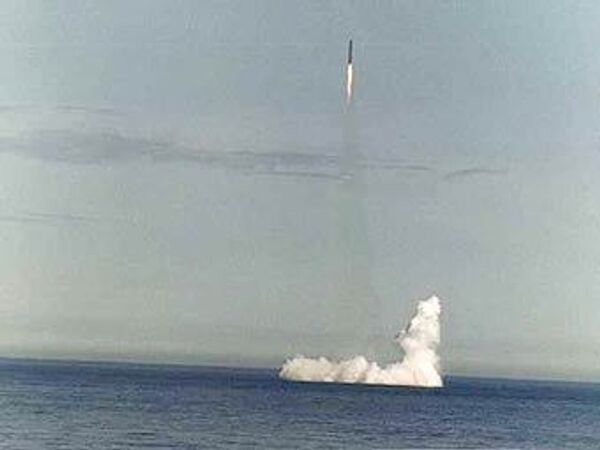MOSCOW. (RIA Novosti military commentator Ilya Kramnik) - The December 9, 2009 test of the RSM-56 Bulava (SS-NX-30) submarine-launched ballistic missile has failed, said the Russian Defense Ministry. There have been 12 other test flights since December 2003.
Without going into technical details, which must be clarified by experts, we must now assess the entire project's status and the implications of the latest abortive test on the future development of Russia's strategic nuclear forces.
The decision to develop the Bulava missile was adopted in 1998 when Moscow's Institute of Thermal Technology was directed to develop an advanced missile system for the Russian navy.
Institute management claimed that it could promptly develop a new ballistic missile based on the Topol M (SS-27 Sickle B) intercontinental ballistic missile, for the Russian navy. This concept was expected to simplify the deployment of the naval component of Russia's strategic nuclear forces and to require less maintenance costs.
Although it is hard to say who initiated such drastic changes, the press claims that Yury Solomonov, director of the Institute of Thermal Technology, Major-General Vladimir Dvorkin, director of the Defense Ministry's Fourth Central Research Institute, Navy Commander Fleet Admiral Vladimir Kuroyedov, the then Defense Minister Marshal Igor Sergeyev, Economics Minister Yakov Urinson and Prime Minister Viktor Chernomyrdin, are responsible for this.
It was decided to deploy the new Bulava missiles aboard the Project 955 Borei class and Project 955A Borei-A class nuclear-powered ballistic missile submarines.
The first submarine of the class, the Yury Dolgoruky, is currently undergoing sea trials. Another two submarines are under construction, and the keel of the fourth Borei class submarine is to be laid before New Year's Eve.
Initial tests of the new missile and its first images revealed that the Bulava will have little in common with the Topol-M. The Bulava was completely different in terms of its appearance, dimensions and warhead lay-out. Nevertheless, the plan had gone too far to back out.
Eleven full-fledged flight tests were conducted between September 27, 2005 and December 9, 2009. Only three launches, specifically the first, second and eighth, were deemed fully successful. Two other launches were rated partially successful.
Facilitating due control over missile component production and ready-made missile assembly, rather than project funding, is the main problem. Moreover, the companies involved require skilled, well-paid workers. However, wage raises alone cannot boost missile quality.
More expensive missiles would be manufactured, unless other measures are implemented.
Some experts think it would be appropriate to upgrade the Bulava missile and to hold a tender for another missile system, due to be installed aboard Project 955 submarines. In their opinion, the program should involve several leading design bureaus, and the most promising project should be implemented.
This would make it possible to develop another missile system for replacing the Bulava if its reliability is not improved.
Russia's president, who oversees the state of the Armed Forces as Commander-in-Chief, would be expected to personally monitor the program because this will ensure due supervision.
The project managers involved should be held personally liable in case of failure because material incentives are ineffective and because resignations no longer scare anyone.
Nuclear-tipped missiles largely facilitate national defense capability. Since the end of World War II and the break-up of the Soviet Union, too many high-ranking officials and production workers have become accustomed to the fact that resignations are the ultimate punishment for incompetence and mismanagement.
Obviously, this concept must be changed with regard to logistics support of the strategic nuclear forces, to say the least, because the price of possible mistakes is becoming too high.
The opinions expressed in this article are the author's and do not necessarily represent those of RIA Novosti.

